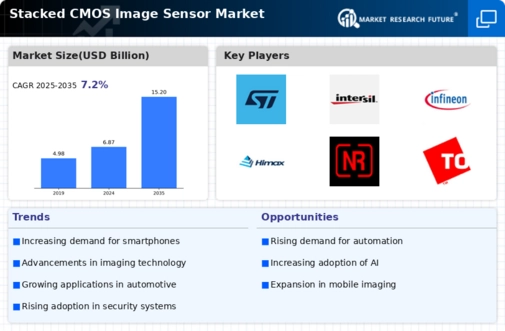Technological Advancements
The Global Stacked CMOS Image Sensor Market Industry is experiencing rapid technological advancements that enhance image quality and sensor performance. Innovations such as improved pixel architectures and advanced fabrication techniques are driving the development of high-resolution sensors. For instance, the integration of AI capabilities into image sensors allows for better image processing and real-time analytics. These advancements not only improve the functionality of devices but also expand their applications across various sectors, including automotive, healthcare, and consumer electronics. As a result, the market is projected to reach 6.87 USD Billion in 2024, indicating a robust growth trajectory.
Growth of the Internet of Things (IoT)
The proliferation of the Internet of Things (IoT) is a notable driver of the Global Stacked CMOS Image Sensor Market Industry. As more devices become interconnected, the demand for efficient and high-performance imaging solutions rises. Stacked CMOS sensors are increasingly integrated into IoT devices, enhancing their capabilities in areas such as smart homes, industrial automation, and healthcare monitoring. This integration allows for real-time data collection and analysis, improving operational efficiency and user experience. The ongoing expansion of IoT applications is likely to propel the market forward, creating new opportunities for innovation and growth.
Rising Demand for High-Resolution Imaging
The demand for high-resolution imaging solutions is a key driver in the Global Stacked CMOS Image Sensor Market Industry. With the proliferation of smartphones, digital cameras, and surveillance systems, consumers and businesses alike are seeking sensors that deliver superior image quality. This trend is particularly evident in the smartphone sector, where manufacturers are increasingly adopting stacked CMOS technology to enhance camera capabilities. The growing emphasis on high-definition video content further fuels this demand. As the market evolves, it is anticipated that the industry will expand significantly, potentially reaching 15.2 USD Billion by 2035, reflecting a compound annual growth rate of 7.46% from 2025 to 2035.
Increased Adoption in Automotive Applications
The automotive sector is witnessing a surge in the adoption of stacked CMOS image sensors, significantly impacting the Global Stacked CMOS Image Sensor Market Industry. As vehicles become more technologically advanced, the need for high-quality imaging systems for applications such as advanced driver-assistance systems (ADAS) and autonomous driving increases. Stacked CMOS sensors provide the necessary resolution and performance for these applications, enabling features like lane departure warnings and collision detection. This trend is expected to drive substantial growth in the market, as automotive manufacturers prioritize safety and innovation, thereby contributing to the overall market expansion.
Emerging Markets and Consumer Electronics Growth
Emerging markets are contributing significantly to the growth of the Global Stacked CMOS Image Sensor Market Industry. As disposable incomes rise and consumer electronics become more accessible, there is an increasing demand for devices equipped with advanced imaging capabilities. Countries in Asia-Pacific and Latin America are particularly noteworthy, as they experience rapid urbanization and technological adoption. This trend is driving manufacturers to invest in developing cost-effective stacked CMOS sensors tailored for these markets. Consequently, the industry is poised for substantial growth, as consumer preferences shift towards high-quality imaging solutions in various electronic devices.
























Leave a Comment